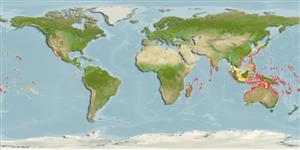Common names from other countries
>
Gobiiformes (Gobies) >
Gobiidae (Gobies) > Gobiinae
Etymology: Fusigobius: Latin, fusus = spindle + Latin, gobius = gudgeon (Ref. 45335).
More on authors: Hoese & Reader.
Environment: milieu / climate zone / depth range / distribution range
Ecologia
marino associati a barriera corallina; distribuzione batimetrica 1 - 46 m (Ref. 90102). Tropical
Indo-West Pacific: East Africa to the Society Islands, north to the Ogasawara Islands.
Size / Peso / Age
Maturity: Lm ? range ? - ? cm
Max length : 6.0 cm TL maschio/sesso non determinato; (Ref. 2798)
Short description
Chiavi di identificazione | Morfologia | Morfometria
Spine dorsali (totale) : 7; Raggi dorsali molli (totale) : 9; Spine anali: 1; Raggi anali molli: 8. Body with dark dots found in rows; spot on caudal peduncle (Ref. 2798); characterized by semi-translucent grey body with orange-brown spots and blotches; outer part of first dorsal fin with two black spots; nearly fully united pelvic fins; weak pelvic frenum; rounded caudal fin; longitudinal scale series 24-25; ctenoid body scales becoming cycloid anterior to pectoral and pelvic fins; operculum without scales; opening of gill extending to or almost to vertical at posterior edge of opercle; depth of body 4.3-5.8 in SL (Ref. 90102).
Inhabits sandy floors of holes and depressions of clear seaward reefs. Also found in sand-rubble bottoms next to reefs (Ref. 90102). Occurs singly or in groups, secretive. (Ref. 37816, 48637). Benthic (Ref. 58302). Feeds on small invertebrates (Ref. 89972).
Life cycle and mating behavior
Maturities | Riproduzione | Spawnings | Egg(s) | Fecundities | Larve
Randall, J.E., 1995. Fusigobius Whitley, a junior synonym of the gobiid fish genus Coryphopterus gill. Bull. Mar. Sci. 56(3):795-798. (Ref. 10930)
IUCN Red List Status (Ref. 130435)
CITES (Ref. 128078)
Not Evaluated
Threat to humans
Harmless
Human uses
Strumenti
Special reports
Download XML
Fonti Internet
Estimates based on models
Preferred temperature (Ref.
115969): 24.5 - 28.8, mean 27.5 (based on 582 cells).
Phylogenetic diversity index (Ref.
82804): PD
50 = 0.5005 [Uniqueness, from 0.5 = low to 2.0 = high].
Bayesian length-weight: a=0.00708 (0.00333 - 0.01504), b=3.09 (2.92 - 3.26), in cm Total Length, based on LWR estimates for this (Sub)family-body shape (Ref.
93245).
Trophic level (Ref.
69278): 3.2 ±0.3 se; based on size and trophs of closest relatives
Resilienza (Ref.
120179): Alto, tempo minimo di raddoppiamento della popolazione meno di 15 mesi (Preliminary K or Fecundity.).
Fishing Vulnerability (Ref.
59153): Low vulnerability (10 of 100).
